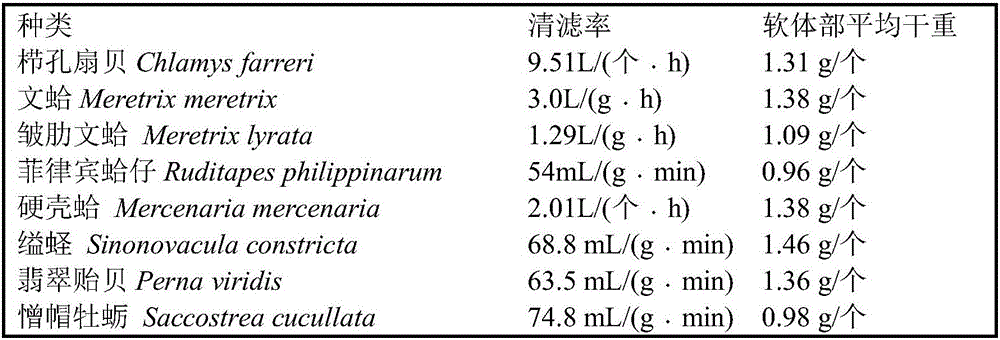Biological prevention and treatment method for cryptocaryon irritans disease
A technology that stimulates cryptonium worm disease and stimulates cryptonium worms. It is applied in the fields of application, climate change adaptation, fish farming, etc. It can solve the problems of difficult large-scale application, time-consuming, labor-intensive and high cost of dragging cages, and achieves operability. The effect of strengthening and strengthening the control effect
- Summary
- Abstract
- Description
- Claims
- Application Information
AI Technical Summary
Problems solved by technology
Method used
Image
Examples
Embodiment 1
[0028] Biological Control of Cryptocaryon stimuli Using Clam Meretrix
[0029] 1 Basis for the selection of Meretrix meretrix
[0030] Put 5 clams in each of the 5 20L water tanks, and the wet weights are 32.5g, 36.2g, 41.1g, 33.6g and 35.6g respectively. The other five 20L tanks do not contain clams. After counting the ciliated larvae within 2 hours of hatching, they were placed in 10 water tanks at a density of 100 / mL. After 3 hours, 6 hours, 12 hours and 24 hours after putting the ciliated larvae in, take 2 mL water samples from the middle water layer at the 4 corners and the center of each water tank with a pipette and place them in a 50 mL small beaker and fix them with formaldehyde with a final concentration of 10% for 10 minutes Let it settle to the bottom of the small beaker. Then, carefully suck off the upper layer of seawater, and transfer the remaining about 5 mL of seawater together with the ciliated larvae to an observation dish. Shake gently to make the cilia...
Embodiment 2
[0036] According to Table 1, the filtration rate of a clam with a dry weight of 1.38 g is 3.0 L / (g h). The dry weight of shellfish mollusk is about 25 times of the wet weight without shell, so the wet weight of 1.38g clams is about 35g. Therefore, the clam filtration rate calculated by fresh weight is 0.12L / (g·h).
[0037] According to Q t = 2V s / 1000CR can calculate 40m 3 The amount of clams put into the indoor cement pool for treatment = 2×40×10 3 ÷0.12L / (g·h)÷1000=666kg. Every 20kg is evenly installed in a hanging cage, and a total of 33 hanging cages are evenly hung in the cement.
[0038] 40m 3 1,000 slant-banded groupers weighing about 100g are cultured in indoor cement ponds. It was found that the fish were not active in eating and their activity decreased. Randomly pick 10 grouper fish. The mucus was scraped from the body surface of each fish, and 1-2 Cryptocaryon stimuli were found under a 400-fold microscope field of view. Confirm infection with Cryptocary...
Embodiment 3
[0040] According to Table 1, the filtration rate of the oyster with soft body dry weight 0.98g was 74.8mL / (g·min). The dry weight of soft body is 0.98g, which is equivalent to 25g fresh weight. Therefore, the filtration rate calculated by wet weight is 2.9mL / (g·min), that is, 0.17L / (g·h).
[0041] According to Q t = 2V s / 1000CR can calculate the amount of oysters in the shallow sea culture cage of 4×4×3 during treatment=2×4×4×3×10 3 ÷0.17L / (g·h)÷1000=565kg. Every 20kg is evenly installed in a hanging cage, and a total of 28 hanging cages are evenly hung in the cage.
[0042] 4 × 4 × 3 shallow sea culture cages are used to breed 500 oblique groupers with a weight of about 200g. Fish eating and activities were normal. When patrolling at night, when the flashlight shines on the fish body, it is occasionally found that some fish bodies have white spots. Take 10 fish and scrape the mucus for microscopic examination. There were 5-10 Cryptocaryon stimuli in the mucus of each f...
PUM
 Login to View More
Login to View More Abstract
Description
Claims
Application Information
 Login to View More
Login to View More - R&D
- Intellectual Property
- Life Sciences
- Materials
- Tech Scout
- Unparalleled Data Quality
- Higher Quality Content
- 60% Fewer Hallucinations
Browse by: Latest US Patents, China's latest patents, Technical Efficacy Thesaurus, Application Domain, Technology Topic, Popular Technical Reports.
© 2025 PatSnap. All rights reserved.Legal|Privacy policy|Modern Slavery Act Transparency Statement|Sitemap|About US| Contact US: help@patsnap.com


